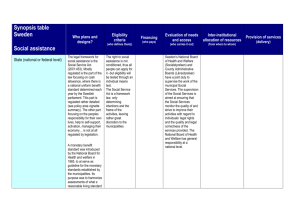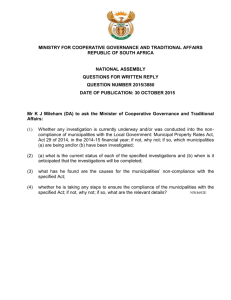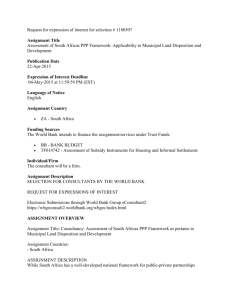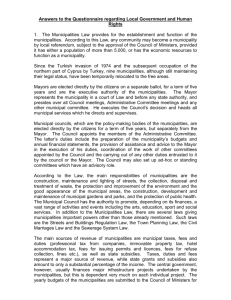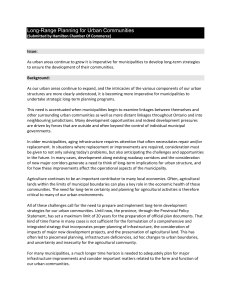Local Economic Development: Linking Theory and Mediterranean Journal of Social Sciences
advertisement
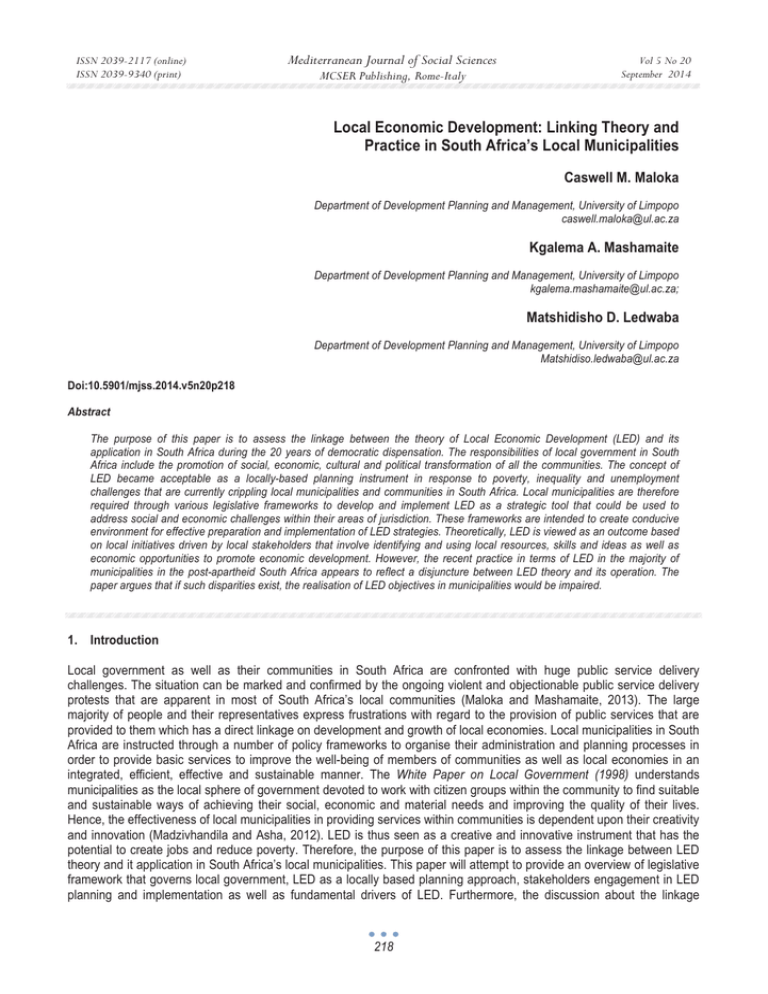
ISSN 2039-2117 (online) ISSN 2039-9340 (print) Mediterranean Journal of Social Sciences MCSER Publishing, Rome-Italy Vol 5 No 20 September 2014 Local Economic Development: Linking Theory and Practice in South Africa’s Local Municipalities Caswell M. Maloka Department of Development Planning and Management, University of Limpopo caswell.maloka@ul.ac.za Kgalema A. Mashamaite Department of Development Planning and Management, University of Limpopo kgalema.mashamaite@ul.ac.za; Matshidisho D. Ledwaba Department of Development Planning and Management, University of Limpopo Matshidiso.ledwaba@ul.ac.za Doi:10.5901/mjss.2014.v5n20p218 Abstract The purpose of this paper is to assess the linkage between the theory of Local Economic Development (LED) and its application in South Africa during the 20 years of democratic dispensation. The responsibilities of local government in South Africa include the promotion of social, economic, cultural and political transformation of all the communities. The concept of LED became acceptable as a locally-based planning instrument in response to poverty, inequality and unemployment challenges that are currently crippling local municipalities and communities in South Africa. Local municipalities are therefore required through various legislative frameworks to develop and implement LED as a strategic tool that could be used to address social and economic challenges within their areas of jurisdiction. These frameworks are intended to create conducive environment for effective preparation and implementation of LED strategies. Theoretically, LED is viewed as an outcome based on local initiatives driven by local stakeholders that involve identifying and using local resources, skills and ideas as well as economic opportunities to promote economic development. However, the recent practice in terms of LED in the majority of municipalities in the post-apartheid South Africa appears to reflect a disjuncture between LED theory and its operation. The paper argues that if such disparities exist, the realisation of LED objectives in municipalities would be impaired. 1. Introduction Local government as well as their communities in South Africa are confronted with huge public service delivery challenges. The situation can be marked and confirmed by the ongoing violent and objectionable public service delivery protests that are apparent in most of South Africa’s local communities (Maloka and Mashamaite, 2013). The large majority of people and their representatives express frustrations with regard to the provision of public services that are provided to them which has a direct linkage on development and growth of local economies. Local municipalities in South Africa are instructed through a number of policy frameworks to organise their administration and planning processes in order to provide basic services to improve the well-being of members of communities as well as local economies in an integrated, efficient, effective and sustainable manner. The White Paper on Local Government (1998) understands municipalities as the local sphere of government devoted to work with citizen groups within the community to find suitable and sustainable ways of achieving their social, economic and material needs and improving the quality of their lives. Hence, the effectiveness of local municipalities in providing services within communities is dependent upon their creativity and innovation (Madzivhandila and Asha, 2012). LED is thus seen as a creative and innovative instrument that has the potential to create jobs and reduce poverty. Therefore, the purpose of this paper is to assess the linkage between LED theory and it application in South Africa’s local municipalities. This paper will attempt to provide an overview of legislative framework that governs local government, LED as a locally based planning approach, stakeholders engagement in LED planning and implementation as well as fundamental drivers of LED. Furthermore, the discussion about the linkage 218 ISSN 2039-2117 (online) ISSN 2039-9340 (print) Mediterranean Journal of Social Sciences MCSER Publishing, Rome-Italy Vol 5 No 20 September 2014 between LED theory and practice in South Africa will be established. 2. Legislative Frameworks for Led in South Afica’s Local Government Local government in South Africa have a considerable role to play in promoting social and economic situations of the poor and disadvantaged within communities. Their obligations are provided by the promulgation of various policies and legislative frameworks including but not limited to the Constitution of the Republic of South Africa (Act 108 of 1996), the White Paper on Local Government (1998), Municipal Structures Act (Act 117 of 1998), Municipal Systems Act (Act 32 of 2000) and Municipal Financial Management Act (Act 56 of 2003). Thus, the Constitution of the Republic of South Africa, 1996 is the important statute from which all other laws are developed. Chapter three of constitution provides for an enabling environment for local government to improve the living standards of the communities. It provides precisely for local municipalities to undertake the developmental role by structuring and managing their administration, budgeting and planning process to give urgency to the basic needs of the communities, stimulate social and economic development and participate in the provincial and national programmes. This suggests that the Constitution support locality based planning and, LED serves as important tool to address local economic issues and promote sustainable economic development. Additionally, the White Paper on Local Government (1998) label the local sphere of government as dedicated to working with local communities and a variety of stakeholders to find sustainable ways to meet their needs and improve the quality of their lives. In order for this to be realised, municipalities are expected to maximise social and economic development opportunities within their local communities through the LED. The Local Government Transition (Act of 1996) and its amendment are major post-apartheid legislations and refer to LED as a municipal strategy aimed to promote economic and social development. The Act assigns numerous powers and functions to local government relating to service provision and requires municipal council to promote integrated economic development, the equitable distribution of municipal resources and the delivery of service with a developmental focus in mind. The mandate for municipalities is additional expressed in the Municipal Structures Act 117 of 1998. The Act provides that executive major must identify the needs of the municipality, review and evaluate those needs in order of priority, recommend to municipal council strategies, programmes and services to address those priorities through integrated development planning from which LED emanate. Additionally, Municipal Systems Act 32 of 2000 requires municipalities to realise developmental local government objectives through the formulation and adoption of a single and inclusive integrated development plan. It assigns municipalities with the responsibility to create and promote economic development in a participatory way that allows for informed municipal decisions and strategies. The Act identifies LED as a means of addressing spatial inequalities that were created by apartheid. The municipal budget come to serve as a tool through which priorities and strategies identified in the LED could be effectively implemented. Thus, the Municipal Financial Management Act 56 of 2003 provides for municipalities to develop budget to ensure the capacity to use, control, monitor, evaluate and manage the resources and performance channeled toward implementation of the LED. 3. Local Economic Development: A Locality Based Planning Approach As elucidated in the preceding sections, the idea of LED has been advanced as a critical solution for poverty alleviation, unemployment and inequality in most of South Africa’s disadvantaged communities. According to Blakely and Leigh (2005), economic development has progressed from being simply measured in economic term such as the Growth Domestic Product which did not quantify the distribution of income and wellbeing. The ideas of development have become the premise with a human component in which development is not viewed only as economics, however, embrace the aspects such as education, gender based development, quality of water, health, employment and poverty. Therefore, LED does not only link economic measures and human aspects of development but goes further to focus on development at micro level (Helmsing, 2001; Kanyane, 2008; Malefane, 2009). LED is a conscious process in which communities are assisted by well-developed institutions to work towards improving the conditions of social and economic development (Cunningham and Meyer-Stamer, 2005). In essence, LED promotes joint development between the local government, community, private sector, NGOs and any other stakeholders (Kanyane, 2008). It is often referred to as a territorial development strategy which is based on endogenous factors such as local economic structure, human resources and institutional arrangement (Rodriguez-Pose and Tijmastra, 2007). This approach to development is a bottom-up socioeconomic strategy that fall within a broader Provincial Growth and Development Strategy to create appropriate business environment to improve their competitiveness (Phago and Tsoabisi, 2010). LED in this context is inextricably linked to developmental local government in South Africa. Hence, LED is a process that is managed by municipalities in accordance with their constitutional mandate to develop local communities. 219 ISSN 2039-2117 (online) ISSN 2039-9340 (print) Mediterranean Journal of Social Sciences MCSER Publishing, Rome-Italy Vol 5 No 20 September 2014 4. Participation in the Led Planning and Implementation Processes The Constitution of the Republic of South Africa, 1996 provides a point of departure in terms of the participation, roles and responsibilities of key stakeholders in matters of governance and development at local government. The Constitution clearly articulate that relevant stakeholders including communities should be involved in the matters relating to development of local communities. Stakeholders and local communities are encouraged not only be involved but rather articulate their needs and influence the decision making during both planning and implementation process of LED. The notion is to promote a participatory approach to development within municipalities in the country. Hence, local governments as agents of development are legally mandated and required to involve local communities and stakeholders in the promotion of social and economic development in order to meet their needs and improve their quality of life. The White Paper on Local Government (1998); Department of Provincial Local Government (DPLG) (2005) and Patterson (2008) identify local government as a sphere of government committed to work with local communities and stakeholders to find sustainable ways to meet their social, economic and material needs and improve their quality of life for all. In essence, local governments are responsible through LED to involve and promote socio-economic development of local communities in the country. Swinburn, Goga & Murphy (2006); Bogopane (2012); COGTA (2010); Mashamaite (2012) and Ramukumba (2012) emphasise that LED is based on the collaboration and partnerships between stakeholders and local communities to find sustainable ways to stimulate and achieve economic growth which will bring economic opportunities and improve the quality of life for all citizens in local communities. As argued by Mashamaite (2013), LED is an outcome-based initiative that should be driven by local communities and stakeholders and involves the identification and harnessing local resources, ideas and skills to stimulate economic growth and development. This means that LED aims at making better use of available local resources and economic opportunities within the community to create jobs, alleviate poverty and enhance economic growth through the involvement of local stakeholders (Hampwaye, 2008). This suggests that, according to Bogopane (2012), the success of LED depend on the active involvement of local stakeholders in the planning and implementation processes of LED. In this case, key stakeholders in South Africa include the public sector (e.g. government sector departments, public-owned enterprises); private sector (e.g. private-owned companies) and nongovernmental organisations (e.g. CBO’s, development agencies) Hence, partnership between the community, government and private sector as well as the rest of civil society should be one of the fundamental components of a successful LED. Bringing all key stakeholders together in a meaningful and effective manner allows for clear conception of the different actors and their roles in LED processes (Rucker & Trah, 2007). However, this remains the biggest challenge for most municipalities around the country. Rucker & Trah (2007) and Davis, Tavasci & Marais (2006) indicate that government in particular local government is arguably the key role player in the LED process and misinterpretation of its role and mandate may severely affect the success of such a process. In most cases, local government is seen as neither best-equipped nor does it have the necessary capacity to drive LED (Rucker & Trah, 2007). On the other hand, the private sector and civil society as well as other stakeholders such as NGO’s must also articulate their interests and commitment to promote socio-economic development of their own communities. Thus, the responsibility for such process lies in the hands of all stakeholders involved. This means that the responsibility to promote and implement LED should not only be vested on the public sector alone if the objectives of LED are to be achieved. The local communities and stakeholders should take a leading role in ensuring that the LED efforts are met and their needs are responded to in an effective and efficient manner. It can, therefore, be argued that a successful LED is ultimately about finding solutions to local problems by bringing together a wide variety of key local stakeholders to address their needs and improve their quality of life. In essence, without adequate involvement and participation of key local stakeholders in the planning and implementation, LED would not strive. The slow implementation and involvement of communities together with other key stakeholders in the LED processes has raised lot of eyebrows and questions in South Africa. Socio-economic conditions in most communities within the country remain less conducive for the poor to have better living standard and for local businesses to strive. 5. Fundamental Drivers of Led in South Africa Appalling levels of poverty, unemployment, inequalities and globalisation have all propelled the need for the South African government to adopt pro poor local economic policy. The increasing status of locality in the global economy and the rising emphasis of local and community decision-making in democratic state have paved the way for LED (Triegaardt, 2007). This meant that the country had to contend with the demands of national issues such as globalisation, rising 220 ISSN 2039-2117 (online) ISSN 2039-9340 (print) Mediterranean Journal of Social Sciences MCSER Publishing, Rome-Italy Vol 5 No 20 September 2014 unemployment, widespread poverty and inequalities affecting most local communities. Globalisation in most developing countries such as South Africa opened wide variety of new opportunities for growth and development (Lawal, 2006). Helmsing (2001) and Walter-Hunter & Jones (2002) argue that globalisation meant wide range of underlying structural reforms such as business organisation, the public-private interface, altered consumption patterns, technological and political change. According to Walter-Hunter & Jones (2002); Rogerson (2009) and Rodríguez-Pose & Tijmstra (2009), globalisation is mostly provoked by the widespread advances in technology and government policy decisions such international trade and investment liberalisation. These trends on the global economy compelled the country to establish pro poor LED as panacea to socio-economic challenges confronting most communities and create favourable environment for business investments at local level. Globalisation is viewed as having the capacity to increase opportunities for growth and development (Lawal, 2006). However, this is not the case in the country due to the fact that most communities are still faced with the triple challenges of poverty, unemployment and inequalities which then raise contentious questions on whether the implementation on LED in the country has lived up to its expectation twenty years since democracy. The failures of the apartheid policies and strategies aimed at providing meaningful reductions of poverty, unemployment, inequalities and the achievement of basic needs of less privileged people in South Africa, have compelled the need for pro poor policies and approaches to the development of communities. Thus, the appalling levels of poverty and unemployment have underlined the need to rethink approaches to promote pro-poor growth and economic development of communities. Nonetheless, poverty and unemployment continues to persist in most communities particularly those in rural settings. This is also attested to and exacerbated by wide gap between the rich and poor in the country as a result of globalisation (Bogopane, 2012). The socio-economic imbalances have always been at the centre of development agenda since the abolishment of apartheid in South Africa. The apartheid left highly unequal society which denied majority of the people equal opportunities in their own country. These conditions impaired the capabilities of people to exploit available economic and employment opportunities to move out of poverty. As a result, these conditions cannot totally be ignored. Hence, there is a need for more robust and inclusive pro poor policy interventions that will create economic opportunities for both businesses and communities to have better conditions to overcome the challenges of poverty, unemployment and inequalities. In this regard, LED is theoretically an ideal panacea to socio-economic challenges facing majority of communities in the country, however, the implementation of such initiative remain arguably the biggest challenge for most municipalities. 6. The Linkage between Led Theory and Practice in South Africa Theoretically, LED is well-positioned to address prevailing socio-economic challenges facing most communities in South Africa. However, these persisting socio-economic conditions in most communities within the country weaken the link between theory and practice of LED. According to Rowe (2009), the theory and practice of LED seems to exist in two different realities. While there is substantial theoretical base for the growth of local economies and highly palpable efforts in LED, the evidence base on the practice of LED is absent or minimal (Rowe, 2009). The theory of LED has always been dominated by how it should be done and less about what it has done so far. Nel (2001) points out that even though application of LED is quite widespread in the country, few tangible results have yet been achieved two decades into democracy. This, therefore, undermines the legitimacy of LED as a panacea to social and economic development and reflects the failures in the way local government pursue LED in the country. Additionally, the capacity and experience of local government seems limited which influence the success implementation of LED in the country (Meyer-Stamer, 2005). This might be due to the fact that local government still undergoing transformation from the apartheid local government system which limited or reduced its roles and responsibilities. The other factor that contributes to the poor results of LED practice is the fact that there is no common understanding of the respective roles of various stakeholders. Often stakeholders do not work together in order to achieve a common goal with no clear effective alignment of priorities (South African Local Government Association, 2010). The confusions related to what really constitute an effective LED also contribute to the misconnection between theory and practice of LED. Thus, it should be noted that strong theoretical frameworks for LED does not guarantee any success in LED. All these factors often reflect the disjuncture that exists between the theory and practice of LED in the country. Evidently, the efforts of LED in the country seems to benefits certain groups of elites within communities in South Africa and more often poor communities and local businesses are neglected in the processes of planning and implementing LED initiatives. This assertion is supported by Bond (2002: 9) who argued that the ‘benefits are unlikely to accrue to the most needy unless they are active participants in new development, with the capacity to plan, monitor and 221 ISSN 2039-2117 (online) ISSN 2039-9340 (print) Mediterranean Journal of Social Sciences MCSER Publishing, Rome-Italy Vol 5 No 20 September 2014 enforce wider benefits’. Another challenge in the implementation of LED is the fact that the responsibility for such process is only assigned to a single unit within the municipality which limit cross-cutting municipal intervention of LED (Malefane, 2009). Malefane (2009) points the challenge to the current municipal structural planning for LED implementation which is bureaucratic and divisional in the sense that such function is designated to a municipal department. This makes the process to be inflexible, rigid and too specialised which could limit the integration of other external support or inputs. 7. Conclusion The purpose of this paper was to conduct an assessment on the connection between the theory of LED and its application in South Africa during the 20 years of democratic government. This purpose was grounded on challenges and the major issues that faced local government during the planning and implementation of LED. As part of providing an objective argument, pertinent background information and legislative prescripts regarding LED in South Africa’s local government were discussed. Furthermore, the paper provided a discussion on LED as a locality based planning approach, stakeholder engagement in LED planning processes, fundamental drivers of LED in South Africa and the challenges facing LED and its operation in South Africa’s local municipalities. It is from this discussion that the paper concludes that there is a disjuncture between LED theory and its application in the majority of South Africa’s communities over the past 20 years of democratic administration. This is supported by the perpetuating levels of poverty, unemployment and inequalities within local communities in the country. References Blakely, E.J. and Leigh, N.G. 2005. Planning Local Economic Development: Theory and Practice (4th edn). Thousand Oaks: Sage Publications. Bogopane, L.P. 2012. Qualitative Analysis of the Local Economic Development Strategy in the Ngaka Modiri Molema District, North West Province, South Africa. Journal of Social Sciences, 30(1): 1-10. Bond, P. 2002. Local Economic Development Debates in South Africa. Municipal Services Project, Occasional Paper No.6. Co-operative Governance and Traditional Affairs. 2010. Guidelines for the Development and Annual Review of Local Economic Development Strategies. Mpumalanga Provincial Government. Cunningham, S. and Meyer-Stamer, J. 2005. Planning or doing local economic development? Problems with the orthodox approach to LED. Africa Insight, 35 (4): 4-14 . Davis, J., Tavasci, D. & Marais, L. 2006. Fostering Rural and Local Economic Development in the Free State of South Africa. Working Note, Natural Resources Institute. Department of Provincial Local Government. 2005. Robust and Inclusive Municipal Economies: Policy Guidelines for Implementing LED in South Africa. Hampwaye, G. 2008. Local Economic Development in the City of Lusaka, Zambia. Urban Forum, 19:187–204. Helmsing, A.H.J. 2001. Local Economic Development: New Generations of Actors, Polies and Instruments. A summary report prepared for the UNCDF symposium on Decentralization Local Governance in Africa. Draft Papers for the 2001 Cape Town Symposium. Kanyane, M. H. 2008. Conceptualizing Local Economic Development as Community Engagement Strategy for Poverty Alleviation. Journal of Public administration, 43(4.1): 698-707. Koma, S.B. 2012. The Evolution of Developmental Local Government in South Africa: Issues, Trends and Options. Journal of US-China Public Administration, 9(1): 53-67. Lawal, G. 2006. Globalisation and Development: The Implications for the African Economy. Humanity & Social Sciences Journal, 1 (1): 65-78. Malefane, S.R. 2009. Structuring South African Municipalities for Effective Local Economic Development Implementation. Journal of Public Administration, 44(1.1): 156-168. Maloka, C.M. and Mashamaite, K.A. 2013. Participation of Government Department in the Integrated Development Planning in South Africa’s Local Municipalities. SAAPAM Limpopo Chapter Conference Proceedings: The Challenges Facing Local Municipalities. SAAPAM Limpopo Chapter. Mashamaite, K.A. 2012. Local Economic Development: An emerging reality in the post-apartheid South Africa. Global Business and Technology Association, Fifteenth Annual International Conference Readings Book. Global Business and Technology Association and EBSCO Publishing. Patterson, C. 2008. Local Economic Development in South Africa. Country Report. Gesellschaft für Technische Zusammenarbeit (GTZ). Meyer-Stamer, J. 2005. Principles for Local Economic Development: Options for South Africa. Gesellschaft für Technische Zusammenarbeit (GTZ). Nel, E.L. 2001. Local Economic Development: A Review Assessment of its Current Status in South Africa. Urban Studies, 38(7): 10031024. Phago, K.G. and Tsoabisi, S.J. 2010. Small, Medium and Micro Enterprises in the South African Local Government. Africa Insight, 40(2): 153-164. 222 ISSN 2039-2117 (online) ISSN 2039-9340 (print) Mediterranean Journal of Social Sciences MCSER Publishing, Rome-Italy Vol 5 No 20 September 2014 Ramukumba, T. (2012). The Local Economic Development in the Eden District Municipality, Western Cape Province, South Africa: A Case Study of Emerging Entrepreneurs in Tourism Industry. American Journal of Tourism Research, 1(1), 9-15. Republic of South Africa 1996. The Constitution of the Republic of South Africa. 1996. Pretoria: Government Printer. Republic of South Africa 1996. Local Government Transition Act of 1996. Pretoria: Government Printer. Republic of South Africa 1998. White Paper on Local Government. 1998. Ministry for Provincial Affairs and Constitutional Development. Pretoria: Government Printer. Republic of South Africa 1998. Local Government Municipal Structures Act, 1998 (Act 117 of 1998). Pretoria: Government Printer. Republic of South Africa 2000. Local Government Municipal Systems Act, 2000 (Act 32 of 2000). Pretoria: Government Printer. Republic of South Africa 2003. Local Government Municipal Financial Management Act, 2003 (Act 56 of 2003). Pretoria: Government Printer. Rodríguez-Pose, A. & Tijmstra, S. 2009. On the Emergence and Significance of Local Economic Development Strategies. CAF Working Paper No.7. Rogerson, C.M. 2009. Strategic Review of Local Economic Development in South Africa. Gesellschaft für Technische Zusammenarbeit (GTZ). Rowe, J.E .2009. The Importance of Theory: Linking Theory to Practice. In Rowe, J.E. eds., Theories of LED: Linking Theory to Practice. Farnham, England: Ashgate Publishing Limited. Rucker, A. & Trah, G. 2007. Local and Regional Economic Development: Towards a common framework for GTZ's LRED interventions in South Africa. Gesellschaft für Technische Zusammenarbeit (GTZ). South African Local Government Association. 2010. Key Issues in Local Economic Development in South Africa and a Potential Role for SALGA. SALGA LED Position Paper. Pretoria: SALGA. Swinburn, G., Goga, S. & Murphy, F. 2006. Local Economic Development: A Primer Developing and Implementing Local Economic Development Strategies and Action Plans. Washington, D.C: World Bank & Bertelsmann Stiftung. Triegaardt, J.D. 2007. Assessing Local Economic Development and Social Welfare Benefits in a Global Context. Waller-Hunter, J. & Jones, T. 2002. Globalisation and Sustainable Development. International Review for Environmental Strategies, 3(1): 53-62. 223

